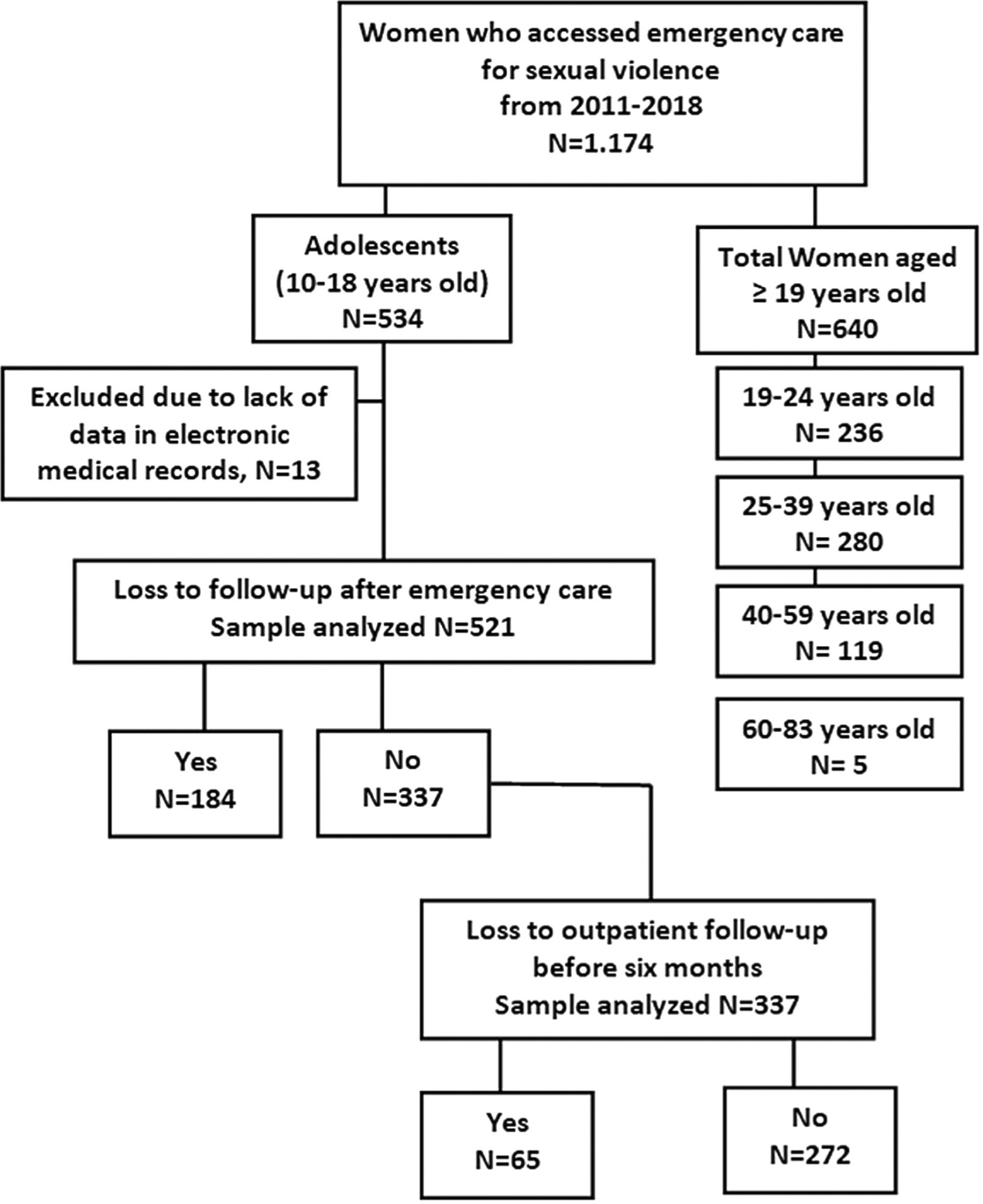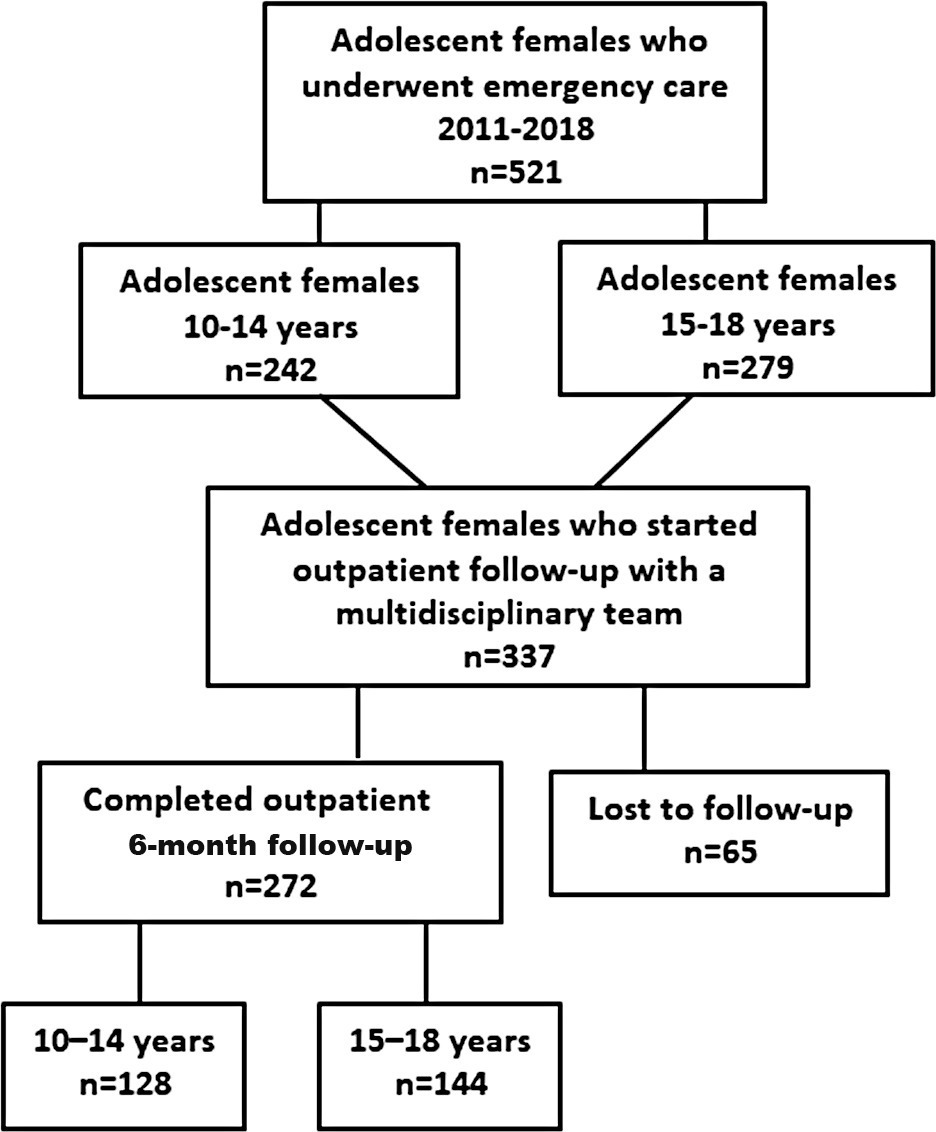Summary
Revista Brasileira de Ginecologia e Obstetrícia. 2023;45(11):661-675
To assess the loss to follow-up after emergency care and during 6-months of outpatient follow-up, and the associated variables, among adolescent sexual violence survivors.
This is a retrospective study with review of the medical records of 521 females, aged 10 to 18 years, who received emergency care in a referral service in São Paulo, Brazil. The variables were sociodemographic; personal history; characteristics of abuse, disclosure, and reactions triggered after abuse (physical and mental disorders as well as social changes), psychotropic prescription needs, and moment of abandonment: after emergency care and before completing 6 months of outpatient follow-up. To compare groups of patients lost to follow-up at each time point, we used the Chi-square and Fisher exact tests followed by multiple logistic regression with stepwise criterion for selection of associated variables. We calculated the odds ratio with confidence interval (OR, CI 95%). The level of significance adopted was 5%.
A total of 249/521 (47.7%) adolescents discontinued follow-up, 184 (35.3%) after emergency care and 65 (12.4%) before completing outpatient follow-up. The variables of living with a partner (OR = 5.94 [CI 95%; 2.49–14.20]); not having a religion (OR = 2.38 [CI 95%;1.29–4.38)]), having a Catholic religion [OR = 2.11 (CI 95%; 1.17–3.78)]; and not disclosing the abuse [OR = 2.07 (CI 95%; 1.25–3.44)] were associated with loss to follow-up after emergency care. Not needing mental disorder care (OR = 2.72 [CI 95%; 1.36–5.46]) or social support (OR = 2.33 [CI 95%; 1.09–4.99]) were directly associated with loss to outpatient follow-up.
Measures to improve adherence to follow-up should be aimed at adolescents who live with a partner and those who do not tell anyone about the violence.

Summary
Revista Brasileira de Ginecologia e Obstetrícia. 2022;44(7):667-677
To compare the sexual violence suffered by women in early and late adolescence, the reactions triggered after the aggression, and the care provided.
A retrospective study in which we reviewed the medical records of 521 female adolescents treated by a multidisciplinary team at a reference hospital in the city of Campinas, state of São Paulo, Brazil. We analyzed sociodemographic variables, and those pertainin to the characteristics of the episodes of violence, the emergency care, and the physical and psychological reactions observed during the follow-up. For the analysis, the sample was divided into groups of early (10 to 14 years) and late (15 to 18 years) adolescence. We used the Chi-squared/Fisher Exact, Mann-Whitney, and Kruskal-Wallis tests to compare the groups; the level of significance adopted was 5%.
The early group (n= 242) contained more adolescents who were enrolled in school (p< 0.001), suffered more daytime aggressions (p= 0.031), in their residences (p< 0.001), by an aggressor with whom they were acquainted (p< 0.001), had greater need of legal protection (p= 0.001), and took longer to seek care (p= 0.048). Feelings of guilt, shame, and the perception of violence were similar between the groups. In the late group (n= 279), there was greater consumption of alcohol during the aggression (p= 0,005); they received significantly more prophylaxis treatments; reported more physical symptoms (p= 0.033), sleep disorders (p= 0.003), symptoms of anxiety (p= 0.045), and feelings of anguish (p= 0.011); and had more prescriptions of psychotropics (p= 0.005). Only 52% completed the 6-month follow-up, with no differences between the groups.
The age groups showed differences in the characteristics of the episodes of violence; early adolescents took longer to seek help, and the late group presented more intense symptoms and psychological worsening during the follow-up. Measures of prevention and specific care aimed at this population are needed.
